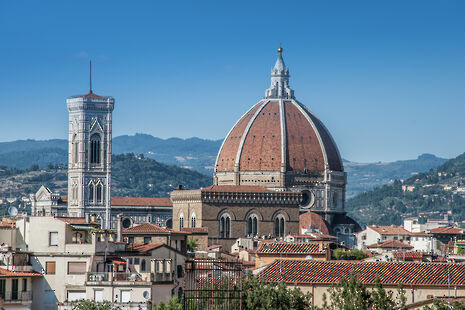Horticultural Espionage: Cambridge undergraduate discovers Medici spy posing as landscape designer
Ted Mackey talks to Davide Martino, the Johnian historian whose dissertation research proved to be rather more exciting than most

Discovering centuries-old secrets from a paper trail of dusty tomes and yellowed letters is something most of us would confine to the realms of Indiana Jones or National Treasure. However, this particular discovery about the clandestine life of Renaissance artist, sculptor, and designer Costantino de’Servi comes not from Harrison Ford or Nicholas Cage, but fourth-year Historian, Davide Martino.
A mild-mannered garden designer to Europe’s nobility, who completed suspiciously few gardens and tended to pop up during suspiciously tumultuous times, the true nature of de’Servi’s double life has been uncovered by the fourth-year student at St John’s. Wherever he travelled, and whoever’s employ he was under, de’Servi remained surreptitiously on the payroll of that most famous, and influential, family – the Medici of Florence.
Davide noted that the discovery came about after his disappointment that there was little record of the wonderful Renaissance gardens that he supposedly worked on. “Then, as I followed the paper trail,” said Davide in The Guardian, “I began to wonder if there was something more interesting going on.”
“Wherever he travelled, and whoever’s employ he was under, de’Servi remained surreptitiously on the payroll of that most famous, and influential, family – the Medici of Florence”
More John le Carré than James Bond, it is likely that de’Servi’s role allowed him to infiltrate the inner circle of Europe’s most powerful families and feed invaluable information back to his paymasters – who’s in, who’s out, who’s courting whom – information that could be very useful in the hands of a powerful family like the Medici. Davide’s discovery, part of his third-year undergraduate dissertation, was made possible thanks to a research grant from St John’s, which allowed Davide to make the journey to Florence and read the relevant archival material.
As for the newfound media attention focused on his research, it has come as a surprise: “It was a stroke of luck out of the blue! It feels a little undeserved, if I’m honest,” said Davide, “I am sure there are undergrad, MPhil and PhD students working on far more interesting stuff – which is not to say I’m not happy, of course!”
Martino believes the best thing about the media attention his work is receiving is the advantages it gives to future historians interested in de’Servi. “I think the best thing about this sudden interest in Costantino de’Servi is that future historians wishing to work on him, or on a related topic, will have more places to start from than I did,” adding, “among the sources I used last year were two unpublished dissertations, and the difficulty wasn’t so much to get hold of a copy, but to know they existed in the first place.”
While many of us would consider making such a discovery the pinnacle of our academic career, Davide has no plans to stop his research into this horticultural intelligence operative. “There is plenty more buried in the State Archives papers, in Florence,” said Davide, “The archival buildings there are massive, and are only slowly being catalogued, so I am certain that, like previous scholars having touched on Costantino in their research, I have only come across a proportion of what’s there.” Unlike his counterpart in the pages of a Dan Brown novel, Davide has the advantage of time to pore over these archives.
As for the future, he is currently working on his MPhil, a research project that looks at the de’Servi family as a whole, not just the clandestine landscape designer for which he has gained media attention. One point of interest is Costantino’s son, Giovan Domenico de’Servi, who moved away from Florence to Neuburg an der Donau in modern-day Germany, in around 1620. It was at this time that he started work as a diplomatic agent for the local German princes rather than for his father’s employers, the Medici.
“His decision is all the more intriguing,” Davide commented, “because, whilst Florence was largely untouched, Germany was the centre of the Thirty Years’ War, a major pan-European conflict. The courts of Neuburg managed to remain neutral throughout, and Giovan Domenico probably helped them negotiate that neutrality.”
Davide is incredibly humble about the significance of his discovery, but its fascinating nature continues to draw interest. As for what might be uncovered in the coming year, he is optimistic: “I was just back at the state archives a couple of weeks ago, to look at Giovan Domenico’s correspondence this time round. It’s early days to say much, but I do hope that by the end of the year, when I need to submit my MPhil dissertation, something will have come up!”
 Interviews / ‘People just walk away’: the sense of exclusion felt by foundation year students19 April 2024
Interviews / ‘People just walk away’: the sense of exclusion felt by foundation year students19 April 2024 News / Controversy on the Cam: John’s spend almost 90 times more on rowing than other colleges19 April 2024
News / Controversy on the Cam: John’s spend almost 90 times more on rowing than other colleges19 April 2024 Theatre / The closest Cambridge comes to a Drama degree 19 April 2024
Theatre / The closest Cambridge comes to a Drama degree 19 April 2024 News / Corpus student left with dirty water for over six months21 April 2024
News / Corpus student left with dirty water for over six months21 April 2024 News / Emmanuel College cuts ties with ‘race-realist’ fellow19 April 2024
News / Emmanuel College cuts ties with ‘race-realist’ fellow19 April 2024





